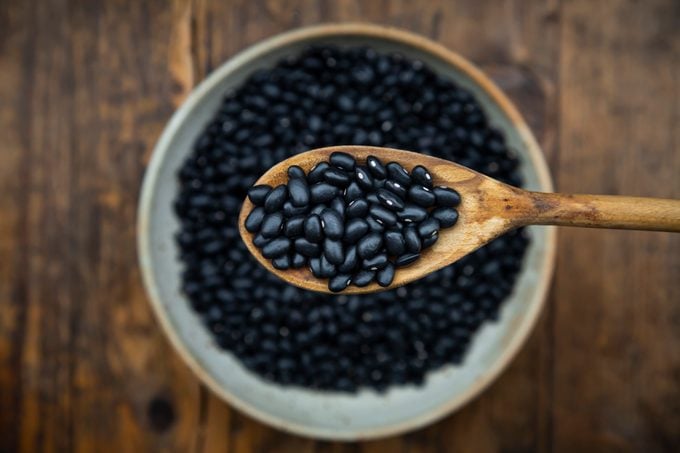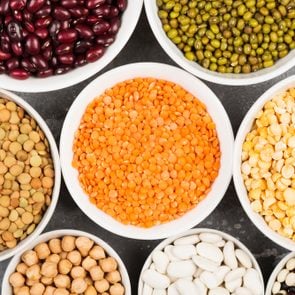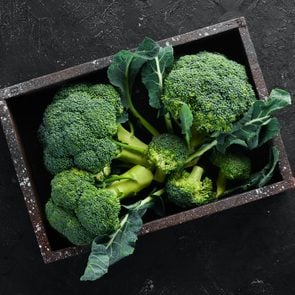Here Are the Calories, Protein, and Nutrition in Black Beans
Updated: Jun. 29, 2021
These are the benefits of black beans, including the nutrition, protein, and calories, as well as how to buy, store, and cook them.
On This Page
Black beans go with everything
If you’ve ever ordered a burrito from your favorite restaurant, there’s a good chance you got to choose the type of beans. No doubt black beans were on the menu.
They’re commonly found in a wide variety of dishes, from veggie burgers to rice-and-bean sides to game-day bean dip.
In many cuisines around the globe, black beans take center stage as a dietary staple. That’s especially true in regions where animal protein is not in abundance.
“Beans are an inexpensive source of protein, fiber, carbs, micronutrients (including folate, which is often lacking in the Western diet), and antioxidants,” says Danielle Gaffen, a registered dietitian nutritionist and nutrition consultant in San Diego.
Black beans are legumes
Black beans are legumes, hailing from a plant family that also includes peanuts, soybeans, and lentils. Technically, they’re known as pulses and are categorized among other dry, edible seeds of plants in the legume family.
Not only are pulses good for you, but they’re also great for the soil, and ultimately the planet, because they help put more nitrogen back into the ground and minimize the need for synthetic fertilizers.
Types of black beans
The plant that gives us black beans is formally named Phaseolus vulgaris, part of the Fabaceae family. Legumes are considered the edible fruit in the Fabaceae family.
Also known as “turtle beans,” black beans have been part of human diets for at least 7,000 years. There are many varieties of black beans, including blackhawk, black magic, domino, and raven.
Black bean nutrition facts
How nutritious are black beans? “Consuming just one half cup of cooked beans can result in higher intakes of fiber, protein, folate, zinc, iron, and magnesium,” Gaffen says.
Here are the nutrition facts, based on one cup of canned black beans:
Calories: 218 (11 percent of recommended daily value, or DV)
Fat: 0.7 grams (5 percent of DV)
Sodium: 331 milligrams (14 percent DV)
Carbohydrate: 35 g (13 percent DV)
Fiber: 16.6 g (66 percent DV)
Protein: 14.5 g (29 percent DV)
Calcium: 84 mg (8 percent DV)
Iron: 4.5 mg (25 percent DV)
Manganese: 1.2 mg (28 percent DV)
Zinc: 1.3 mg (9 percent DV)

Health benefits of black beans
These tiny beans are a major health win.
“Black beans are a good source of iron, folate and plant-based protein,” says Susan Greeley, a registered dietitian and chef instructor at the Institute of Culinary Education in New York City.
Plus, they’re packed with fiber, and that alone offers protection against diseases.
“Higher-fiber foods like black beans offer many health benefits to people with health conditions such as constipation, diabetes, heart disease, and cancer,” Gaffen says.
They round out a plant-based diet
Protein is a vital nutrient for the body, and black beans are a great source of plant-based protein. If you follow a vegetarian, vegan, or otherwise plant-centric diet, black beans are a wonderful option.
Not only can they help make up for protein deficits from not eating animals, but they can make up for a lack of iron too.
“Vegetarians who rely on beans as a source of iron can eat foods with vitamin C to help increase iron absorption,” adds Rachel Naar, a registered dietitian and nutrition consultant in New York City.
They have plenty of fiber
Fiber-rich foods are important for the body. Eating plenty of fiber can keep the digestive tract healthy.
“High fiber is good for bowel movement regulation,” Naar says.
Black beans contain soluble fiber, a type of fiber that isn’t digested but is beneficial for the intestinal tract.
“From a gut health perspective, black beans provide soluble fiber and nondigestible carbohydrates that help to fuel good gut bacteria,” Greeley says.
Gaffen points to beans’ oligosaccharides (short-chain sugar polymers) and resistant starch, both of which act as prebiotics, a type of food that feeds healthy bacteria in the intestinal tract.
Consuming enough fiber can also help you feel full longer, aiding weight management.
“The soluble fiber and resistant starch in beans may help suppress appetite and manage blood sugar,” Gaffen says. “Whole food sources of fiber, like black beans, are the best because you’re getting a boost in many different nutrients at once.”
They may help with blood-sugar management
The body digests foods at different speeds, based on the kinds of carbs, fats, and proteins they have.
Quickly digested foods (like hard candy or white rice) have a high glycemic index and tend to spike blood sugar levels. Foods with protein and fiber take longer to digest and have lower glycemic indexes.
Some experts suggest eating low-glycemic foods to help prevent a rapid increase in blood sugar levels at mealtime.
Black beans are “good for blood sugar because they have a low glycemic index, which can help keep blood sugar in a healthy range,” Naar says.
And here’s a promising piece of research for any rice-and-beans lovers with diabetes: combining black beans or other legumes with rice may help minimize the increase in blood sugar levels after a meal.
According to a randomized controlled trial published in the journal Nutrients in 2017, black beans reduced blood glucose when eaten with white rice. It’s worth noting this study was small, however, with only 12 subjects, all women.
“Black beans [and all other legumes] play an important role in diets geared toward managing chronic diseases such as diabetes and heart disease,” Greeley says.
They may help protect against disease
“[Black beans] have been shown to be protective against certain types of cancer, including colon cancer, and are praised for their role in combating cardiovascular disease,” Greeley adds.
One reason they may be so heart-protective is that legumes have been linked to lower blood pressure and lower cholesterol. When those get out of hand, they raise the risk for heart disease.
Risks and side effects of black beans
Black beans are considered a safe and beneficial food in moderation for most people, but they aren’t perfect. Here are a few potential downsides of eating black beans.
You can have gas or bloating
You know how the children’s rhyme goes: Beans, beans, they’re good for your heart; the more you eat them…”
Well, you know the side effect. The reputation for causing flatulence is deserved.
“Gases [hydrogen, methane, and carbon dioxide] are produced by intestinal bacteria when they ferment the bean’s indigestible carbohydrates, such as raffinose and stachyose,” Gaffen says.
Humans don’t have the necessary enzyme to digest the complex sugars, also known as oligosaccharides, says Greeley. When bacteria ferment these indigestible carbohydrates in the digestive tract, they produce hydrogen, methane, and carbon dioxide gases.
The result: you get gassy.
Consuming a high-fiber diet is important, but you don’t want to rush into eating more fiber-heavy foods too quickly. Doing so can cause bloating and constipation.
“If you are trying to increase the amount of fiber in your diet, make sure to do so gradually, while drinking plenty of extra fluids,” Gaffen suggests.
The FODMAPs may aggravate IBS
Some people with irritable bowel syndrome (IBS) may want to limit their consumption of black beans due to the presence of FODMAPs: fermentable oligosaccharides, disaccharides, monosaccharides, and polyols.
These are types of carbohydrates found in certain foods, including wheat and beans. Black beans are “high in FODMAPs, which can cause digestive symptoms in people with irritable bowel syndrome,” Naar says.
If you have IBS, your doctor or dietitian may recommend a low-FODMAP diet.
They may lessen mineral absorption
Beans contain phytic acid, a compound found in many plants that helps protect seeds from premature germination, Greeley says.
Phytic acid can bind to minerals like calcium, magnesium, and copper and may prevent nutrients from being absorbed into the body, Greeley says.
This is why phytic acid is sometimes referred to as an antinutrient.
While that’s a downside, it’s not usually reason to stop eating black beans. Phytic acid is also an antioxidant, so eating beans is more beneficial and tends to outweigh the risk of lessened mineral absorption.
How to choose black beans
The two primary ways to buy black beans are dried or canned.
Canned black beans
Having the pantry stocked with a few cans of black beans can definitely help with meal preparation.
You can toss these versatile beans into salad for some extra protein, make a quick meal with bean-focused burritos, or make wholesome veggie burgers.
It’s important to note most canned beans have lots of sodium, but rinsing them before eating can reduce the sodium content by 40 percent, Gaffen says.
Dried black beans
Dried beans are more affordable and lack the sodium or other additional ingredients that may be found in canned beans.
They give you flexibility to make a variety of dishes, but you will need to plan ahead, as they usually need to soak overnight. (More on how to soak and cook dried beans below.)
Canned vs. dried beans
If you’re wondering which is the best option, know that it depends on your lifestyle.
“The difference boils down to time, convenience, cost, and preference,” Greeley says. “If you want a large amount, I recommend cooking the beans. The cooked beans are very versatile and can also be frozen.”
How to store black beans
Dried beans are best kept in an airtight container in a dry, cool area. They will typically last for up to a year when stored properly.
Canned beans also need to be stored in a dry spot, such as a pantry or cupboard.
How (and why) to soak dried beans
Preparing dried beans takes some planning because you’ll need to soak them before cooking.
“Dry beans require soaking before cooking to help make them more digestible and remove unwanted components, like reducing the phytic acid content,” Greeley says.
If you’re inspired to make a pot of beans but can’t soak them overnight, there’s also a quick-soak option: boil them for two minutes and then remove them from the heat, letting them soak in the hot water for one hour before cooking, Gaffen says.
It is possible to cook beans without soaking in advance. If you go this route, you’ll need to use double the amount of water and double the cooking time, Gaffen says.
The ratio of beans to water is typically one cup of beans to three to four cups of water. “Two cups of dried beans require six to eight cups of cold water,” she says.
How to cook dried beans
There are plenty of delicious ways to cook dried beans. The process is fairly straightforward.
“After soaking for approximately 10 hours, they are either drained and combined with fresh water for cooking or simmering directly in their soaking liquid until tender,” says Gaffen.
The cook time usually is around 1.5 hours.
There are a few other things to consider before preparing a pot of beans.
“When cooking black beans, it’s important not to use hard water and not to add salt or acid in the form of tomato products or lemon juice until the beans are well-cooked, because these substances inhibit the softening of pectic compounds,” she says.
In other words, the beans will be difficult to soften and you may end up crunching hard beans. Not so tasty.
Inspiration for how to eat them
Although beans are a versatile food that can be eaten in myriad ways—from entrées to side dishes to baked goods—they are still not eaten as frequently in the United States as in many other parts of the world.
“Dietary guidelines for Americans recommend eating dry beans daily as a healthy protein source, yet most Americans do not eat them at all,” Greeley says.
Black beans are inexpensive, easy to use, and can be convenient for a quick meal if you make them ahead of time and freeze them or buy them canned.
“They can be added to salsa or pureed as a side dish with a splash of olive oil and cracked pepper. They can also be turned into a black bean soup or easily added into other soup varieties,” Gaffen says.
Black beans “are great for salads, dips and hummus, or they can be cooked in soups, chilis, and other main dishes. They can also be used in baking,” Greeley adds.
Black bean recipes
Summery black bean and tomato salad
Courtesy of Susan Greeley
Ingredients:
- 2 avocados, peeled and cut into chunks
- 3 tomatoes, stems removed and chopped into small wedges
- 1 seedless cucumber, peeled and cut into chunks
- 1 (15-ounce) can of low-sodium black beans, drained
- ¼ cup chopped fresh basil leaves
- ¼ cup olive oil
- 3 tablespoons balsamic vinegar
- Salt and pepper to taste
Directions:
- Combine all of the ingredients in a bowl, except for the salt and pepper.
- Toss well to coat with the oil and vinegar.
- Add salt and pepper to taste.
- The salad can be served immediately or can be refrigerated for several hours before serving.
Healthier beanie brownies
Yield: 16 brownies
Courtesy of Danielle Gaffen
Ingredients:
- 1 (15-ounce) can of black beans
- 1.5 teaspoons baking powder
- ¾ cup unsweetened cocoa powder
- ¼ teaspoon salt
- 1 teaspoon vanilla extract
- 1/3 cup maple syrup
- 8 prunes
- 2 oz avocado
- 2 tablespoons ground flax seeds
- Sprinkle of mini dark chocolate chips
Directions:
- Preheat the oven to 350° F.
- Lightly grease an eight-inch square glass baking dish.
- Rinse and drain the black beans.
- Combine all of the ingredients, except for the chocolate chips. Pulse until smooth.
- Stir in the chocolate chips. Evenly distribute the batter into the pan.
- Bake for 25 minutes. The top should be dry, with edges starting to pull away from sides.
- Remove from the oven and let cool 30 minutes.
- Refrigerate for two hours before cutting.
Next, try these 12 delicious canned bean recipes.
























